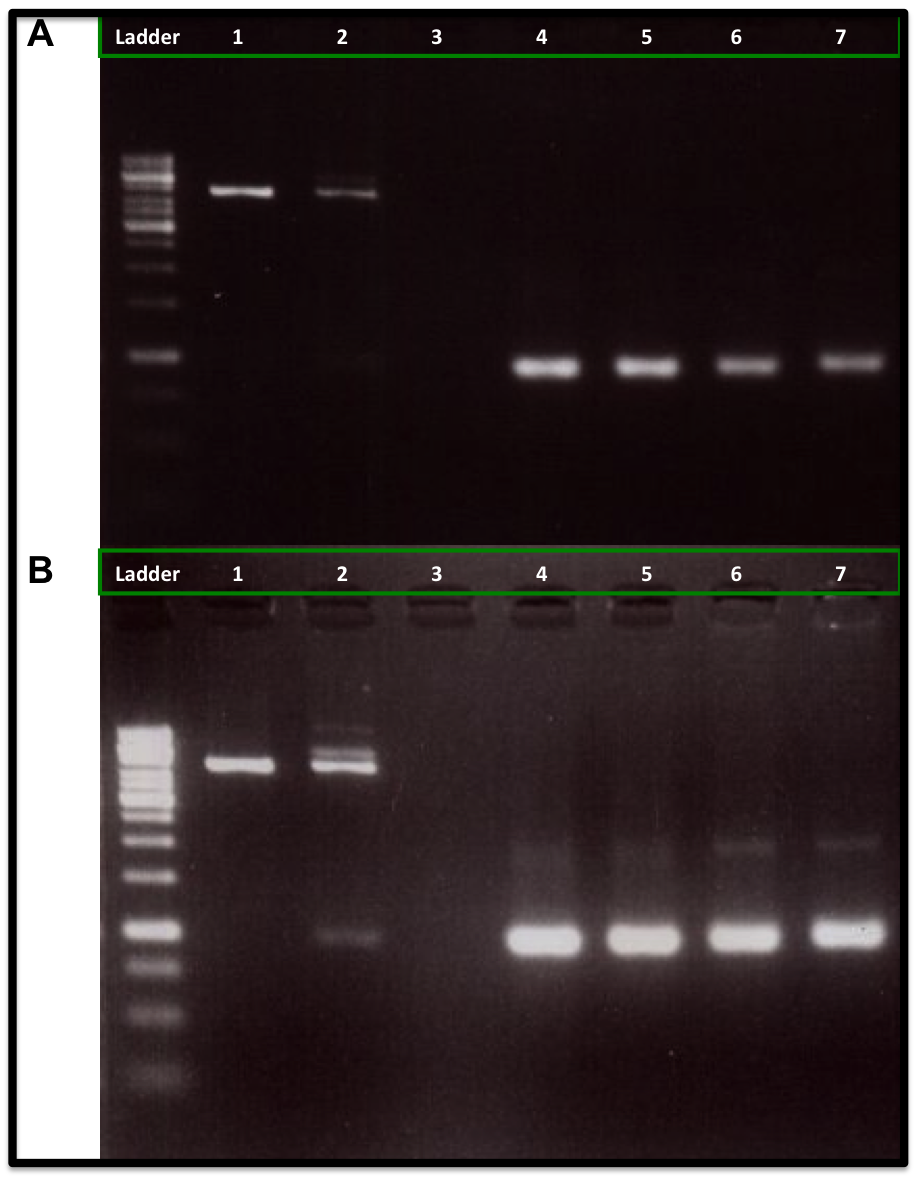Team:USP-UNESP-Brazil/Plasmid Plug n Play/Results
From 2012.igem.org
Andresochoa (Talk | contribs) |
Andresochoa (Talk | contribs) |
||
| Line 7: | Line 7: | ||
Based on the report made by the igem2010 UT-Tokyo team and some papers (e.g http://www.ncbi.nlm.nih.gov/pmc/articles/PMC137435/), the lox66 (BBa_I718016) from the registry was wrong, it had a gg instead a cg in its left arm. This part was corrected by the iGEM11_Tokyo_Tech team (BBa_K649206) and by the iGEM11_WITS_CSIR_SA team (BBa_K537019), but no DNA was available in the registry. Anyway, we needed to synthesized it and test it as part of our PCR-primers, we used the proper sequence described by http://www.ncbi.nlm.nih.gov/pmc/articles/PMC137435/. | Based on the report made by the igem2010 UT-Tokyo team and some papers (e.g http://www.ncbi.nlm.nih.gov/pmc/articles/PMC137435/), the lox66 (BBa_I718016) from the registry was wrong, it had a gg instead a cg in its left arm. This part was corrected by the iGEM11_Tokyo_Tech team (BBa_K649206) and by the iGEM11_WITS_CSIR_SA team (BBa_K537019), but no DNA was available in the registry. Anyway, we needed to synthesized it and test it as part of our PCR-primers, we used the proper sequence described by http://www.ncbi.nlm.nih.gov/pmc/articles/PMC137435/. | ||
| - | We designed two primers, one containing the lox66 and one containing the loxP sequence, these primers amplified the ORF from the kanamycin resistance gene, flanked upstream by the loxP and downstream by the lox66, using PCR. These sites should be recognized by the Cre recombinase (from NEB company), which could circularized our linear PCR product. This is important because we don't want it to be degraded when inserted in the bacteria. This ''In vitro'' assay | + | We designed two primers, one containing the lox66 and one containing the loxP sequence, these primers amplified the ORF from the kanamycin resistance gene, flanked upstream by the loxP and downstream by the lox66, using PCR. These sites should be recognized by the Cre recombinase (from NEB company), which could circularized our linear PCR product. This is important because we don't want it to be degraded when inserted in the bacteria. This ''In vitro'' assay was a test for a posterior ''In vivo'' assay, where we expect that this process happens inside the ''E. coli'' using a Cre recombinase enzyme expressed by the same bacteria. |
Revision as of 12:35, 26 September 2012
 Introduction
Introduction Project Overview
Project Overview Plasmid Plug&Play
Plasmid Plug&Play Associative Memory
Associative MemoryNetwork
 Extras
ExtrasIn vitro assay
This experiment was made to test if the loxP and the lox66 were working properly, it also allowed us to measure the Cre concentration needed for an in vitro recombination reaction. The particularity of lox66 is that it has an altered sequence at the end of it's left arm when compared to loxP (natural recombination site from P1 Bacteriophage). This sequence variation reduces affinity of the Cre recombinase for the arm.
Based on the report made by the igem2010 UT-Tokyo team and some papers (e.g http://www.ncbi.nlm.nih.gov/pmc/articles/PMC137435/), the lox66 (BBa_I718016) from the registry was wrong, it had a gg instead a cg in its left arm. This part was corrected by the iGEM11_Tokyo_Tech team (BBa_K649206) and by the iGEM11_WITS_CSIR_SA team (BBa_K537019), but no DNA was available in the registry. Anyway, we needed to synthesized it and test it as part of our PCR-primers, we used the proper sequence described by http://www.ncbi.nlm.nih.gov/pmc/articles/PMC137435/.
We designed two primers, one containing the lox66 and one containing the loxP sequence, these primers amplified the ORF from the kanamycin resistance gene, flanked upstream by the loxP and downstream by the lox66, using PCR. These sites should be recognized by the Cre recombinase (from NEB company), which could circularized our linear PCR product. This is important because we don't want it to be degraded when inserted in the bacteria. This In vitro assay was a test for a posterior In vivo assay, where we expect that this process happens inside the E. coli using a Cre recombinase enzyme expressed by the same bacteria.
Our experiment showed that 5U and 10U of Cre recombinase produced a reduction of linear DNA (Kanamycin resistance gene flanked with loxP and lox66) when compare to 1U of Cre recombinase and to the control DNA (No Cre recombinase added), as is showed in the figure A. It was also observed an increase of the DNA plasmid form (upper band at 2kb), as is showed in figure B. We also used a control DNA substrate supplied in the NEB recombinase kit.
The conclusion was that we can use this loxP-lox66 mechanism in our design and we will need at least 5U of Cre recombinase for any in vitro experiments.
In vivo assay
We proved that we can circularize a fragment of DNA (Kanamycin resistance gene) flanked by a loxP and a lox66 sites in vitro, so we decided to test Plug&Play prototype,
codnkjjjjjjjjjjj
We found one colony growing in a LB plate with kanamycin, showing that the fusion was possible. Which is really a good result, because the pGEM plasmid has no RBS, so it is reported that it can be use to express but the expression is really low.
Based on the report made by the igem2010 UT-Tokyo team and some papers, the lox71 (BBa_I718017) from the registry was wrong, it had a cg instead a gc in its center sequence that is between the arms.
Apparently, this part was corrected by the iGEM11_WITS_CSIR_SA team (BBa_K537020), but the sequence from this group had the same error. The corrected part from iGEM11_Tokyo_Tech (BBa_K649205) was right but no DNA was available in the registry. So we decided to synthesized it and test it, using the proper sequence described by http://www.ncbi.nlm.nih.gov/pmc/articles/PMC137435/, and we submitted the correct DNA to the Registry.
 "
"
















